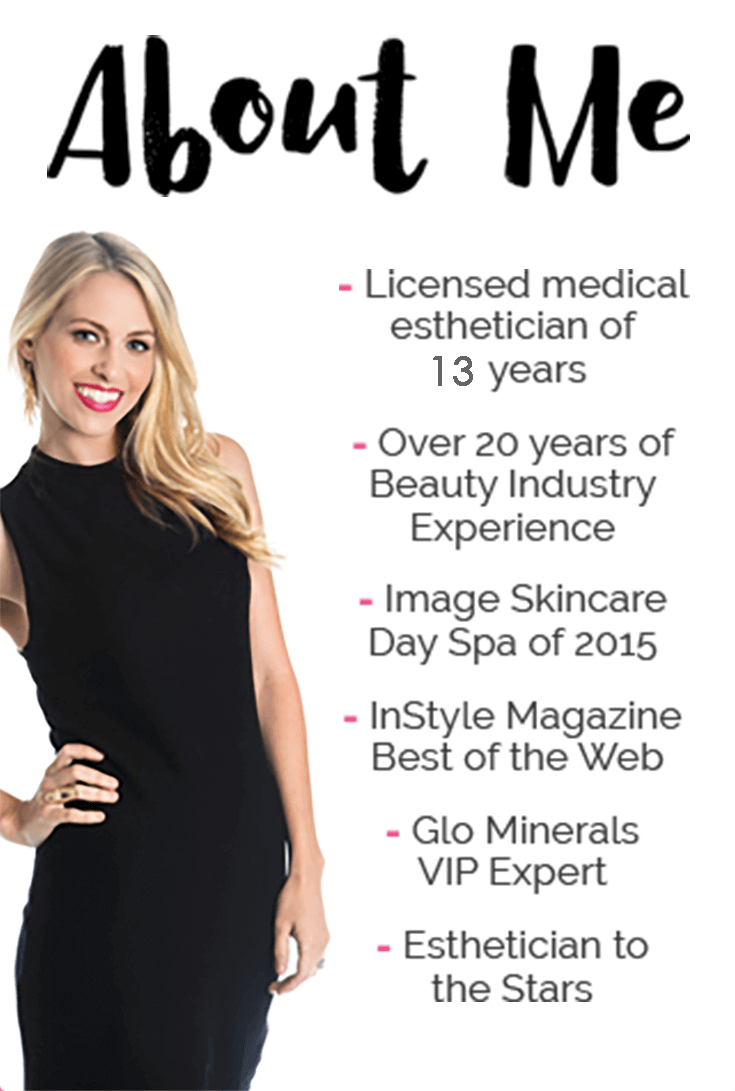What Should You Be Using In Your Skin Care Routine?
Take my quiz and get personalized recommendations from a
licensed esthetician!
How to Keep Skin Healthy During Chemotherapy
A cancer diagnosis is life-changing.
If you are going to receive chemotherapy treatment, or you are currently receiving chemotherapy treatment, I know your world may feel like it’s turning upside down.
This topic particularly hits home for me as my dad passed away from cancer.
I want to help make things easier for you by tackling the topic that I have firsthand experience with.
While chemotherapy can certainly wreak havoc on your beauty routine — your skin, hair, and nails — many survivors, such as Caitlin Kiernan, author of Pretty Sick: The Beauty Guide for Women With Cancer, say that:

When lots of things seem out of your control, it feels good to have a routine.
For some women, this is where perfecting their cancer beauty routine may come into play.
Unfortunately, your skincare routine during chemo likely won’t be the same as your skincare routine pre-diagnosis (or post-chemo, for that matter).
This is because there are many “normal” products that are big no-nos to use while undergoing chemo.
In this blog post, we’ll be going through how chemotherapy can affect your skin, what products you can and can’t use during chemotherapy (and why), and what to expect from your skin post-chemotherapy.
As always, follow the instruction of your doctor/medical practitioner first!
You may have special circumstances or certain priorities that don’t align with the “typical” patient, so it’s always pertinent that you follow any medical advice before taking into account any of my tips.

How Chemotherapy Can Affect Your Skin
When we hear the phrase, “you look sick,” it’s generally referring to our skin.
Even if we’re keeping our skincare high on our list of priorities, chemotherapy can throw skin out of whack.
According to Mayo Clinic, “Chemotherapy is a drug treatment that uses powerful chemicals to kill fast-growing cells in your body.”
While there are different chemicals used in different patients, the general premise of chemotherapy is the same across the board.
The methods of your chemotherapy specifically can vary—treatments can be given intravenously (IV), orally (through pills), through shots, or even creams.
Regardless of the treatment method, the majority of chemotherapy will come with severe side effects.
Some side effects, such as hair loss and weakened immune system, are well-known, but skincare is a little less discussed.
So, let’s discuss it now!
Generally, chemotherapy causes your skin to become more dry and sensitive (to products, and to the sun).
Some treatments can cause your skin to become discolored as well.
These effects can also apply to your hair and nails.
Of course, when we’re dealing with major health issues and stressors, our skin can be the last thing on our minds, but there are some important reasons why you should keep your skin healthy during this time.
For example, sensitive and dry skin may be prone to eczema or itching, which can lead to sores, which can lead to infections — and that’s the last thing you need on top of everything else you’re dealing with.
Just like you would have before chemo, the best way to treat dry skin is with lots of moisturizing products (such as a cream or oil-based product).
You’ll also want to avoid any sun exposure and try to avoid exposing your skin to any extreme weather conditions (for example, wear gloves to protect your hands in the wintertime).
To help prevent dry skin, you will also want to avoid artificially scented products, long/hot showers or baths, lanolin-based products, foaming products, and any potential allergens.
Other tips? Try to hold off on shaving for as long as possible.
If you must shave, try using a conditioner or an oil-based product rather than foaming shaving cream, and don’t use any perfumed after-shave products.
If possible, wearing cotton clothing will be gentler on sensitive, dry skin.
And lastly, although you likely already are doing this, make sure you’re drinking enough water.
As an added measure, try to avoid caffeinated products and alcohol, as these diuretics can actually have the opposite effect.

If you continue to have cracked, flaking, or peeling skin; along with itching, swelling, sores, or a rash—it might be more than just dry skin.
Hand-Foot syndrome (palmar-plantar erythrodysesthesia) is a common side effect of chemotherapy.
Although it’s not certain how Hand-Foot syndrome is caused (some believe that the medication leaks into the small blood cells of the hands and feet), it is certain that there’s no medication to cure it easily.
However, a way to help prevent it, similar to preventing dry skin, is to cover your hands and feet from elements.
Doctors also recommend avoiding putting pressure on your hands and feet for up to a week after receiving chemotherapy.
Another common side effect of chemo on your skin is what doctors refer to as “flushing.”
Flushing is simply a temporary redness or patches of redness that show up on your skin — generally on your face and neck — as a reaction to the dilation of your blood capillaries.
Flushing can be caused by certain chemotherapy drugs, or they may be caused by carcinoid tumors.
Flushing can also be caused by alcohol or other drugs.
Something else your skin might undergo during your chemotherapy is hyperpigmentation
Hyperpigmentation is the darkening of the skin, sometimes this occurs throughout your skin as a whole, but more often the hyperpigmentation is localized in certain areas.
During chemotherapy, some drugs may result in the hyperpigmentation of your nails, tongue, gums, and finger joints.
Other drugs (notably busulfan, cyclophosphamide, cisplatin, ifosfamide, thiotepa, docetaxel, and etoposide) may cause for the darkening of areas under pressure, such as the parts of your skin that are under bandages or tape.
Another drug called Methotrexate is known for causing “flag signs” (hyperpigmented bands) in the hair of patients with lighter colored hair.
The last well-known pattern of pigmentation occurs when a patient takes medication (specifically fluorouracil and vinorelbine) intravenously (via IV), which can result in a darkening of the veins.
The good news is that in most cases, any of the aforementioned hyperpigmentation that shows up within the first 1-3 weeks of chemotherapy will disappear around 10-12 weeks after your last round of chemotherapy.
Unfortunately, there’s not much you can do in the meantime — but you have bigger fish to fry!

Why You Can’t Use Certain Skincare Products During Chemotherapy
Another problem you may run into (which we’ll go into more detail on later) is that your skin might react negatively to certain products.
Unfortunately, even products you used with no problems before chemo aren’t safe, so you have to be extra careful.
For example, you’ll want to avoid any products that contain artificial fragrances, alcohol, or preservatives.
If you’ve read my blog before, you may know that I generally advise against any products with these ingredients already.
These ingredients can lead to irritation even in the average user, but for someone going through chemo, it’s even more important to avoid any products containing the aforementioned items, because your skin will be extra sensitized.
The last thing you want to deal with is a skin reaction from a cupcake-scented body lotion.
Another thing to watch out for, if you’re based in the US, is products that have been linked to cancer.
Unfortunately, while the EU has outlawed over 1,300 toxins from being used in products, the US has only outlawed around 30—which is why, unfortunately, you have to screen products yourself.
Avoid any products containing parabens, synthetic colors, phthalates, triclosan, sodium lauryl sulfate (SLS)/sodium laureth sulfate (SLES), BHA, formaldehyde, toluene, and propylene glycol,
Other products/ingredients you need to watch out for include the following:
Antioxidants
While antioxidants can be great for pre-chemo skin, antioxidants can interfere with your cells during chemo, which makes them a no-no for chemo patients.
Botanical Essential Oils
While many women have found success with essential oils during their post-chemo recovery (aromatherapy is always nice), you should not use essential oils while still undergoing chemotherapy.
According to Robert Tisserand, author of Essential Oil Safety, “
Any Skincare Purchased Through a Third Party (Like Amazon)
It’s difficult enough to determine what’s in our skincare products sold from reputable brands, but the waters get even murkier when dealing with a third party seller like Amazon.
Countless reports have been filed where consumers have found counterfeit beauty products sold on Amazon, Target, and other retailers that we generally trust.
While you should never skimp on skincare (and if a deal is too good to be true, it probably is), during this time in your life it’s even more important to be extra careful with what you expose your skin to.
If you can, always buy products directly from the source (i.e., buy an Epicuren product from Epicuren.com).
You may also like to know that Whole Foods, Trader Joe’s, and Costco have been found to have some of the strictest product standards, so you should feel safe purchasing skincare at any of their stores.

The Products/Ingredients You CAN Use During Chemotherapy
When looking for what to substitute your now (sadly) unusable beauty products with, look for products that are hypoallergenic, gentle, and hydrating.
And of course, products that are natural and have ingredients that you recognize on the label.
Unfortunately, because the US doesn’t regulate terms like “natural” and “organic,” you have to do a little Nancy Drew sleuthing yourself — don’t trust a pretty label too quickly!
In terms of what kinds of products to use, here are some recommendations:
Urea Moisturizers
While chemo affects everybody differently, one effect that is extremely common among all patients is very dry skin.
Not only are urea moisturizers excellent (and safe) for preventing and treating dry skin, they also have been shown to help prevent Hand-Foot Syndrome.
Urea moisturizers have also been shown to reduce itchiness, dryness, and scaliness more effectively than glycerin-based moisturizers.
A 10% urea cream is generally what’s recommended.
Hand Creams
While you can certainly use the urea cream on your hands (and you might want to), you also may want to consider having a travel-sized hand cream on hand (or in all your purses, your glove compartment, etc.).
Oil or Lotion-Based Cleansers
We already discussed why you should ditch alcohol-based products, and this includes your cleanser.
But, you also should probably switch out your water-based cleanser for something oil or lotion based.
You know that tight feeling you get after washing your face? You don’t want that!
That feeling is actually the product stripping your face of its natural oils, and you want to keep those!
Heavy Duty Healing Ointments
There’s a reason why Vaseline works wonders on your chapped lips.
It works as a barrier against the elements.
During chemo, you’ll want a similar product to protect your skin from the outside world, as it’ll be extremely sensitive during this time.
Ask your doc for a recommendation on this one!
Castor Oil
Of course, hair loss is a natural side effect of chemotherapy for most patients.
While this blog post is mostly focused on skincare, I want to mention castor oil as a great natural and safe option to stimulate hair growth.
You can rub castor oil into your scalp, onto your eyebrows, and even on your eyelashes to help stimulate growth.
Brands I Love
One easy way to weed out all the non-chemo friendly skincare products? Search for “oncology friendly” products.
Of course, like always, being “oncology friendly” doesn’t always mean they’re safe during every stage of chemo or every type of cancer, so always check with your doctor first.
Osmosis products ar available on my site and are "oncology" friendly.
The StemFactor Growth Serum is a great product to give you that “healthy” glow.
Other cancer survivors have sworn by products from Farmaesthetics, Skin And Co., and 100% Pure.
Other Resources for Products
Another resource for finding safe to use products is Think Dirty, which verifies “clean” beauty brands.
Environmental Working Group’s Skin Deep database, on the other hand, allows you to look up your favorite products and see if they contain any ingredients that present a potential risk.
Of course, you do not want to use any of the products here without first consulting your doctor.
As I mentioned, every patient and every treatment plan is unique, and your doctor’s word always comes first.

Post-Chemotherapy: What To Expect From Your Skin
The good news is, as I mentioned before, lots of the pesky skincare issues you deal with during chemo will clear up a couple of weeks after you finish chemo.
Unfortunately, the battle with cancer doesn’t always stop at chemo.
In many cases, you’ll still be on a slew of medications and treatments after chemo, and these can also mess with your skin.
Many women who have gone through chemotherapy have unfortunately struggled with acne in the after stages.
Other women noticed a complete change in their skin tone and felt the need to purchase a new foundation to match with their new shade.
Even if you can go back to the products you used pre-cancer diagnosis, you may need to completely revamp your routine for your skin and it’s ever-changing needs.
But there’s nothing wrong with a little trial and error, and luckily there are plenty of women who have gone through similar things that can lend a helping hand or suggestion!
You may also want to go back to the basics and check out my chapter by chapter series on how to get perfect, younger, and healthy skin.
Specifically, consider reevaluating your skin type —it may have changed!
Final Thoughts
I know you may be going through a lot right now, and I hope I’ve helped in a small way by providing you with this blog post!
If you’ve had personal experience dealing with chemotherapy, I’d love to hear about how you treated your skin and what worked (or what didn’t) before, after, and during your treatments.
Top Brands
New Brands

Recent Posts

Are You Taking the Right Steps to Care for Your Skin?
Take the Quiz
Skincare Secrets!
10-step guide for healthy, beautiful skin after kids.
100% privacy. I will never spam you!














